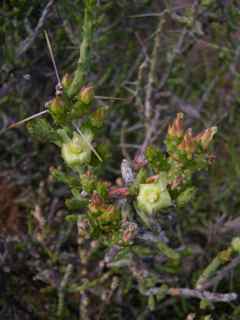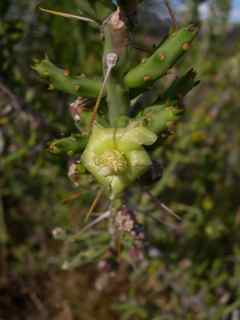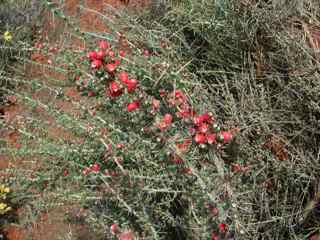|
|
 Spines Max Licher @http://swbiodiversity.org, Usage Rights: Creative Commons Attribution-ShareAlike (CC BY-SA) |  Flower Max Licher @http://swbiodiversity.org, Usage Rights: Creative Commons Attribution-ShareAlike (CC BY-SA) |  Fruit Max Licher @http://swbiodiversity.org, Usage Rights: Creative Commons Attribution-ShareAlike (CC BY-SA) | | | |
|
Origin:
Native Similar Species: Cylindropuntia arbuscula
General Desc:
Upright, shrub-like plant with many branches made up of slender, cylindrical joints. Often grows at the base of other shrubs or mixed with grasses. The branches often twist together with the branches of adjacent plants to form inpenetrable thickets.
Identification notes: A smaller cholla, usually under 3 feet tall, slimmest branches of any cactus. Fruit is red and remains on plant through winter. The fruits are one way to distinguish this plant from the similar Arizona pencil cholla, as it has dull green fruits.
Height:
2 to 5 feet
Width:
Habitat Description: Washes, slopes and flat areas.
Plant Communities:
Desert Scrub, Interior Chaparral, Semidesert Grasslands
Elevation: 1000 - 5000 feet
Color:
Greenish-yellow
Flowering Period:
Apr - Aug
Description:
Flowers to 1 inch wide. Sometimes flowers in fall.
Stem Color:
Dark green
Number of Stems:
Multiple
Stem Shape:
Cylindrical
Stems Segmented:
Y
Stem Surface:
Ribbed
Stem Description:
Up to 1/2 inch diameter, cylindrical and branched to 16 inches long. The new segments are dark green; they can also appear grayish-green to purplish. Segments have rib-like wrinkles. With age the branches and trunk develop a scaly bark and turn pale tan.
(structures unique to cacti, found on the stems, areas from which spines, flowers and fruits emerge)
Areole Description:
Areoles white to yellow, felty, aging gray; broadly elliptic. There is usually just one white or golden brown spine per areole. Lower stem areoles are more likely to be spineless.
Spine Color:
Grayish
Spines Hooked:
N
Spine Description:
There is usually just one white or golden brown 2-inch long spine per areole.
Glochids: Y (Glochids are minute barbed hairs or bristles)
Glochid Description: Glochids in crescent to encircling areole, yellow or reddish brown.
Fruit Color: Red
Fruit Notes: Bright red to 1/2 inch long and wide, becoming fleshy at maturity. Fruit remains on stems much of winter.
|
|